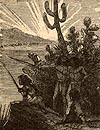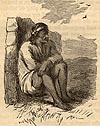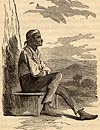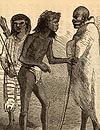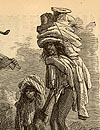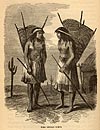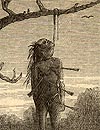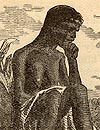[From] Chapter I. The Gadsden Purchase.
I have thus at some length attempted to account for the
tardy growth of this interesting Territory. It will be
admitted that there is good reason why Arizona has failed
to attract a population. With wonderful resources and a
climate equal to that of Italy, it has suffered a series of
misfortunes unparalleled in the history of our territorial
possessions. Two great obstacles to the prosperity of the
country still exist: difficulty of access, which can only
be remedied by a port on the Gulf of California; and the
hostility of the Apache Indians, for which there is no
remedy short of extermination.
[From] Chapter IV. Fort Yuma.
Next day Superintendent Poston and myself held a grand
pow-wow with the Yuma chiefs and their people. From all
parts of the neighborhood they came; warriors, squaws, and
children; from the mesquit bushes and mudholes of the
Colorado; from the sloos and the arroyas of the Gila; the
cotton-woods and the deserts and the mountains of Castle
Dome. Every village had its delegation of dusky
tatterdemalions. Lizards and snakes and mice were hastily
cast aside in the wild anticipation of muck-a-muck from the
Great Father. Hungry and lean, painted and bedizened with
ornaments, they came in to receive the bounty of the mighty
Federal chief. Great were the rejoicings when we opened the
boxes and bales of merchandise so liberally furnished by
the Government contractors, Cronin, Huxtall, & Sears,
of New York. Red, white, green, and gray blankets; military
suits, glittering with tinsel; old swords, four feet long;
sun-glasses for lighting cigars; and penny whistles for the
small fry. It was indeed a wonderful display of the
artistic triumphs of civilization, well calculated to
impress the savage tribes of the Pacific with awe and
admiration. There were axes of the best Collins brand, that
flew to pieces like glass against the iron timbers of this
anomalous region; and hats made by steam, and flaming red
vests stitched by magic, and tobacco-boxes and tin kettles
that might be opened, but never upon earth shut again.
Surrounded by all the military paraphernalia of Fort Yuma,
and with ceremony the most profound and impressive, we
delivered our speeches and dry goods to the various chiefs;
we gave them damaged hominy and hoes, and spades and
shovels, and sashes and military buttons, charms, amulets,
tobacco-boxes, and beads; shook them by the hand
collectively and in detail, and pow-wowed generally in the
approved style.
Pasqual, the doughty head-chief of all the Yumas, long
known to fame as the longest of his tribe, predominated
over the ceremonies. A grave, cadaverous, leathery old
gentleman, with hollow, wrinkled cheeks, and a prodigious
nose, through the cartilage of which, between the nostrils,
he wears a white bone ornamented with swinging pendants, is
Pasqual the doughty. On account of the length of his arms
and legs--which, when stretched out altogether, bear a
strong similitude to the wind-mill against which Don
Quixote ran a tilt--the mighty Pasqual is regarded with
much respect and veneration by his tribe. His costume, on
the present occasion, consisted of a shabby military coat,
doubtless the same worn in ancient times by his friend,
Major Heintzelman, the embroidery of which has long since
been fretted out by wear and tear, and the elbows rubbed
off by long collision with the multitudes of
offïce-seekers among his tribe. Of pantaloons he had
but a remnant; and of boots or shoes he had none at all,
save those originally furnished him by nature. But chiefly
was Pasqual conspicuous for the ponderous bone and
appendages that hung from his nose. A slight catarrh
afflicted him at the time of our pow-wow, and it was not
without great inconvenience that he managed the ornamental
part of his countenance--turning repeatedly away to blow
it, or adjust the awkward pendants that swung from it, and
always reappearing with tears of anguish in his eyes. I
took pity upon his sufferings and gave him some snuff,
assuring him it was a sovereign remedy for colds in the
head. The result was such a series of explosions,
contortions of the facial muscles, and rattling of the
ornamental bones, as to alarm me for the sanity of the
doughty chief, who seemed quite wild with the accumulation
of his agonies. The assembled wisdom of the nation grunted
repeatedly in token of amazement; and Pasqual muttered,
between the paroxysms of his affliction, "Ugh! muchee
pepper belly strong dust! Burn 'um Injun nose!"
Vincente, the next chief in command, dressed in a blue
cotton shirt of the scantiest pattern. It reached only a
short distance below his waist, and, for the matter of
respect to the prejudices of civilization, might have ended
at the collar. I really wish the contractors would furnish
longer shirts for the Indians. The Yumas are tall, and I
know of no tribe on this coast averaging only fourteen
inches from the crown of the head to the soles of the feet.
Vincente had probably received a hint that the distribution
would be honored by the presence of ladies. What he lacked
in costume he made up in paint. Both his eyes were
encircled with yellow ochre; blue streaks adorned his
cheeks; his nose was of a dazzling vermilion, and his legs
were gorgeously striped with mud. His only additional
article of costume, visible to the eye, was a dusky cotton
diaper, ingeniously tied behind, leaving a long tail to
flutter majestically in the breeze.
Tebarro, the next great chief, wrapped himself in an
American blanket, and dyed his face a gloomy black. I think
he was in mourning. He wore tar on his head, and tar on his
cheeks, and tar on his nose and chin, which becoming
mingled with the grit and dust of the Colorado desert, gave
him a sort of asphaltum look, like the house-tops and
pavements of Los Angeles. When he stood in the sun he
melted--such was the force of his grief. Black tears ran
down from his head and cheeks and chin, and mingled with
the wool of his blanket. Literally he wept tar.
Antonio, the fourth great chief, wore a strap round his
waist, with a rusty old sword tied to it by means of
rawhide. He didn't wear any thing else, save the usual
girdle of manta upon his loins, that could be considered an
article of costume; but his eyes were gorgeously encircled
by a cloud of blue paint fringed with vermilion. Like his
illustrious superior, Pasqual, he wore pendent ornaments in
his nose, of the most inconvenient pattern. I should judge
Antonio carried a quarter of a pound of native jewelry,
consisting of bone and lead, upon the cartilage of his
proboscis.
Juan, the fifth and last of noted warriors and head-men,
was redundant in gamoose breeches and cotton rags. On his
head he wore a helmet of Colorado mud, dried into the roots
of his hair by the action of the sun. This I believe is
accounted by the Yumas a sovereign remedy for vermin. The
liveliest skipper is forever deprived of locomotion by the
conglomerate of dried mud. When the helmet is broken off in
segments, like a piece of baked crockery, it must present a
curious spectacle of embalmed bodies.
These distinguished chiefs and their people received the
presents allotted to them with great dignity and
good-humor. There was no grabbing or stealing, nor any sign
of discontent. Every man received his share with
satisfaction, and with gratitude to the Great Father in
Washington. When they shook hands with us for the last
time, and we were about to part, the scene was really
affecting. I almost shed tears at it myself, unused as I am
to crying about what can't be helped. In squads, and
couples, and one by one, they affectionately took their
leave, with their hoes and axes, spades and shovels,
gimcracks and charms stuck all over them--in their sashes,
breeches, clouties, blankets, and pinafores. One went with
a necklace of mattocks around his neck and three Collins
axes in his girdle; another with his head thrust into a
glittering pile of tin-ware; while a third, one of the
unbreeched multitude, wore a flying pan in front by way of
an apron, and a corn-hoe behind, in the usual fashion of a
rudder. Old men and young were tuning their jews'-harps;
luxurious squaws were peeping at the redundant beauties
reflected by their little zinc looking-glasses; children
were blowing their tin whistles, and small fat papooses
were hanging their heads out of compressed bundles behind
their mothers, wondering, with open mouths and great round
eyes, what could be the cause of all the hubbub. It was an
impressive scene of barbarous happiness not easily
forgotten. And so ended the Grand Pow-wow.
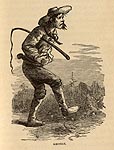 Our unhappy driver, George, who had never smiled during the
whole course of the ceremonies, now turned away with an
expression of the most profound and confirmed melancholy.
Not even the warrior with the rudder, nor the chief with
the mud roof to his head, could dissipate the intensity of
his gloom. Nor were the blandishments of the dusky Yuma
belles of any greater avail. With his hand pressed upon the
pit of his stomach he groaned in agony of spirit as he
descended the hill; and I fancied the plaintive words
reached my ears, "Oh! Mary Jane, how could you? Think of
him that loves you, and he among Injuns and
savigges!"
Our unhappy driver, George, who had never smiled during the
whole course of the ceremonies, now turned away with an
expression of the most profound and confirmed melancholy.
Not even the warrior with the rudder, nor the chief with
the mud roof to his head, could dissipate the intensity of
his gloom. Nor were the blandishments of the dusky Yuma
belles of any greater avail. With his hand pressed upon the
pit of his stomach he groaned in agony of spirit as he
descended the hill; and I fancied the plaintive words
reached my ears, "Oh! Mary Jane, how could you? Think of
him that loves you, and he among Injuns and
savigges!"
[From] Chapter IX. The Pimo Villages.
The number of Pimo villages is 10; Maricopas, 2;
separate inclosures, 1000; total population, 6000. In 1858,
the first year of the Overland Mail Line, the surplus crop
of wheat was 100,000 pounds, which was purchased by the
Company; also a large quantity of beans called
taperis, and a vast quantity of pumpkins, squashes,
and melons. In 1859 Mr. St. John was sent among them as a
Special Agent with a supply of seeds and some agricultural
implements. That year they sold 250,000 pounds of wheat and
a large supply of melons, pumpkins, and beans. In 1860 they
sold 400,000 pounds of wheat--all the Mail Company would
purchase. They had more, and furnished the Government and
private teamsters all that was necessary for transportation
from Fort Yuma to Tucson. Beyoud this they had no market,
except for about 40,000 pounds of wheat which Mr. White
purchased for the supply of Fort Breckenridge. In 1861 they
sold to Mr. White 300,000 pounds of wheat, 50,000 pounds of
corn, 20,000 pounds of beans, and a large amount of dried
and fresh pumpkins, which was all intended for the supply
of the California column. The greater part of this crop was
destroyed or given back to the Indians by the Texans under
the guerrilla, Hunter, who arrived at the Pimo villages
that year, robbed Mr. White of his property, and took him
prisoner in their flight to the Rio Grande. The Pimos sold,
during the same year, 600 chickens and a large amount of
other stuff, showing a gradual increase of production under
the encouragement of an increased demand. In 1862 they sold
to the Government over a million pounds of wheat, included
in which was a portion of the previous year's crop,
returned to them by the Texans. They furnished pinole,
chickens, green peas, green corn, pumpkins, and melons for
the entire California column, subsisting nearly a thousand
men for many months. In 1863 they furnished the Government
with 600,000 pounds of wheat, and disposed of about 100,000
pounds made into flour and sold to miners and traders.
Their crop was smaller than usual, owing to the breakage of
their main acequia at a critical period of the season, and
in January, 1864, they were nearly out of wheat, but still
had a good supply of other products.
It will thus be seen that the Pimos are not a race to be
despised. They have always proved themselves good warriors,
and have been uniformly successful in resisting the
incursions of the Apaches. Their villages have afforded the
only protection ever given to American citizens in Arizona.
If it were not for the Pimos and Maricopas it would now be
impossible to travel from Fort Yuma to Tucson.
|
